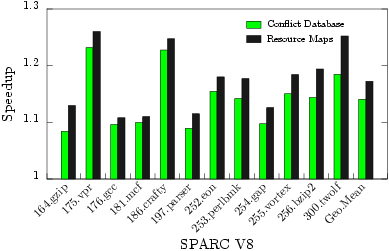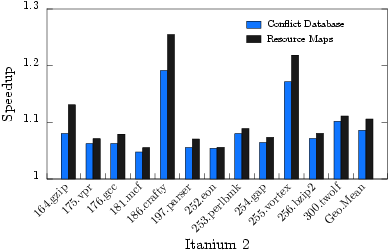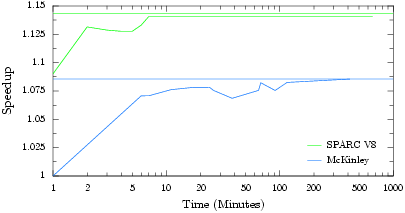Reverse-Engineering of Structural Hazards for Instruction Scheduling
Generation of high quality code for modern and embedded processors requires a compiler to maximize utilization of available resources. An essential step in this is the aggressive scheduling of instructions while avoiding stalls from structural hazards. To do this, an optimizing compiler must be aware of the processor's available resources and how these resources are utilized by each instruction. The typical process of manually discovering and specifying this resource information is both tedious and error-prone. Ideally, given a processor or processor model, structural hazards would be determined automatically.
Why would you want to reverse-engineer structural hazards? First, machine information needed for compiler development is not always available or, when available, accurate. Second, evaluation with a tuned optimizing compiler is important during the design space exploration of a computer system, where it is necessary to rapidly explore several candidate designs. Since the quality of the system depends on the number of candidate designs that can be explored, the ability to rapidly retarget an instruction scheduler is critical. However, retargeting the compiler's instruction scheduler to a new candidate design is particularly tedious and time-consuming due to the many complex interactions between instructions and the tight coupling to specific design implementation details.
|
Isn't reverse-engineering a processor impossible? Yes! Formal models, such as used by ADLs, can allow a processor model to be reverse-engineered. However, it is impossible to automatically discover all structural hazards without such formal models. Our technique automatically reverse engineers the most important structural hazards. This technique uses observations about the properties of processors to identify a subset of instruction schedules to explore. Structural hazards found during exploration are used to infer the existence of other structural hazards. The subset of instruction schedules formed is based on three observations:
How well does it work? The technique was used to build a conflict database, containing known and inferred structural hazards, which was then used for hazard detection during scheduling. As the graphs to the right show, the structural hazards we discover and infer are sufficient to obtain 80-100% of the performance of perfect resource maps when scheduling. Additionally, the bottom right graph shows the speedup of the technique over time. Almost all of the speedup is achieved within 3 hours, with almost all of the performance obtained in under 15 minutes. |



|
